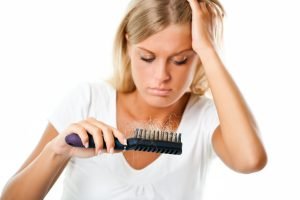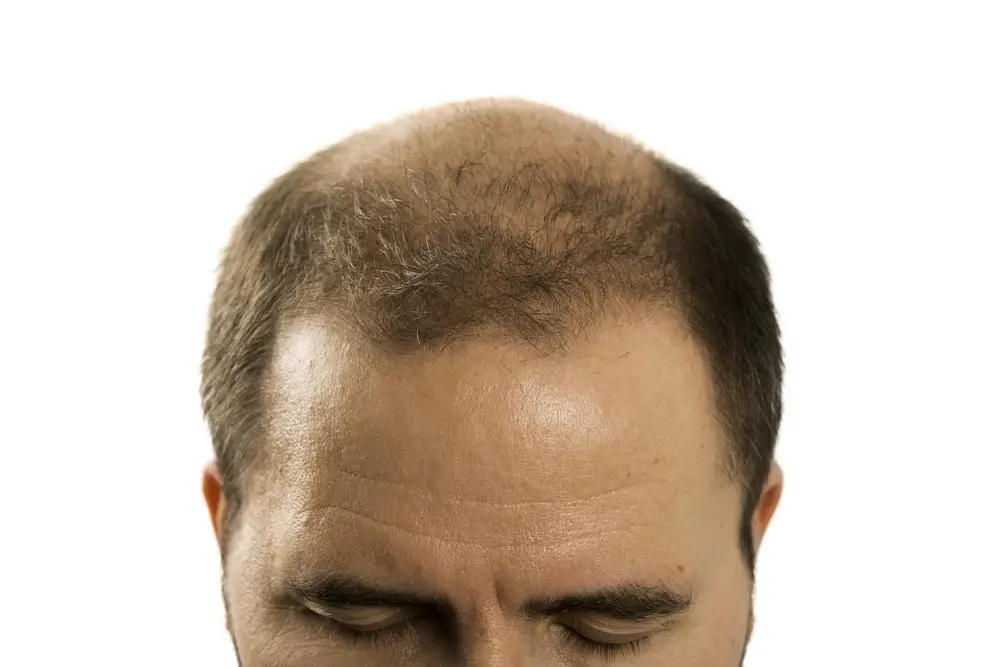
Page Contents
You might be surprised just how many people suffer from hair loss. The fact is that hair loss has so many causes that almost everyone suffers from it a little or a lot at some point in their lives. Sometimes people have hair loss without even realizing it.
This is because hair loss starts off small more often than not, and sometimes it stays that way. However, other times hair loss will start off small and then keep getting worse and worse.
If you have various family members with hair loss and a strong desire to keep your hair, you have every reason to be concerned. In this case, it is vital to learn the early signs of hair loss. Doing what you can to prevent it beforehand is just as important.
Catching and preventing hair loss as early as possible may not be able to keep it at bay entirely. However, it will lessen the hair loss you end up suffering with and can make more drastic treatments unnecessary when they otherwise would have been needed.
Early Signs of Hair Loss
You may think that not losing the normal 50 to 100 strands of hair per day when you brush means that you are in the clear, but that may not be the case. With sudden hair loss, yes, you will notice a difference almost immediately. In this case, there will be no early signs to warn you.
On the other hand, gradual hair loss is just that. Gradual. Where and how the first signs start showing up will depend on the type of hair loss that is starting to affect you. The first signs of male pattern baldness, for example, will be different from the first signs of general hair loss.
Hereditary
Male Pattern Baldness is the first thing that likely comes to mind when thinking of hereditary hair loss. For this type, the early signs are usually first visible on your hairline. At first, this will be the hairline at your temples or forehead more often than not. You will also notice thinning on the crown of your head.
Taking the occasional picture of your hairline before you start losing any hair can help you see the change early. At any rate, having a specific place to look at can help catch it as soon as possible.
Just make sure that you check your hairline in the same type of lighting each time, since a change in lighting can and often will affect what your hairline looks like.
Medical Conditions

Though pattern baldness is technically a medical condition, it is not the only one that affects your hair. However, the other conditions are ones that are usually not hereditary. Ringworms, for example, can cause redness and itching of the scalp and can also make your hair brittle.
There are a handful of funguses that have various appearances. These are more obvious than simple hair loss, though, and each has a different appearance. Psoriasis is one example of a condition that can affect the scalp and has a unique, scaly appearance.
Alopecia areata is where your immune system attacks your hair follicles. Tinea capitis is a fungal infection on the scalp that causes scaly spots and pustules. This actually scars your scalp over time, causing irreversible hair loss eventually.
Besides specific medical conditions that directly affect your scalp, there are others that affect it indirectly. For example, thyroid problems are not a scalp disease, but it can cause you to lose your hair all the same.
Long illnesses, regardless of the type, can wear down a person’s body too. In this case, the early sign will most likely be a general thinning of your hair. The same goes for hormonal imbalances in women as they age, though this can mimic the effects of pattern baldness.
Others include diabetes, lupus, and chronic stress, in particular, is a big one. Sudden weight loss or weight gain, along with deficiencies and poor diet, can also cause a general thinning of your hair.
Excessive itchiness of your scalp can be caused simply by dandruff, which is technically a condition. However, this itchiness can also be a sign of something else as well. If combined with burning and tenderness, it signifies a type of infection – which will often lead to hair loss in that area.
A Few Others To Note
Apart from medical conditions, medications can also cause hair loss as a side effect. This can be tricky to determine, more so if you started more than one new medication at a time. Once you pinpoint that it is a medication, and which one, then you can talk to your doctor about switching.
However, the medication that is causing your hair loss may be chemotherapy for some type of cancer. In that case, switching is not an option, and the hair loss is unavoidable. There may be other cases where switching medication is simply not an option as well.
Finally, physical, or even mental, trauma can also cause hair loss, though this tends to be sudden. It also doesn’t qualify as a medical condition per se, but yet it is at the same time.
What To Look For With Early Signs
Now that you know the many different types of early signs, let’s look at them as a whole. Finding hairs on your pillow, either more than normal or some when there used to be none, is a clear sign. The same goes for the amount of hair you find on your brush or after your shower.
To catch this, pay attention to the amount of hair you usually lose in each of those cases. That way, you will notice when and if the amount changes. Keep note that, the less frequently your brush or wash your hair, the more hair you will see.
That is because the hairs were already loose and needed an opportunity to finish falling out. It is perfectly normal, so keep this in mind to avoid giving yourself a scare. It is especially true for curly hair, as the curls keep hold of the strands that have technically already fallen out until you brush.
Though it is all well to look for hair thinning, this can be surprisingly hard to notice, much less verify. However, there are some ways to determine for certain and things to look at.

Testing Thickness
If your hair is hopefully long enough to go into a ponytail, then do so. You don’t have to wear your hair in a ponytail for any great length of time. Ponytails are simply a perfect way to measure how much volume your hair has when it is all scrunched as tight as possible.
Doing this often just to check will show you if your hair is getting thinner quite easily, because your ponytail will get smaller. You can do this with just your hand, but it is easier to see if you use a hair tie.
Next, your part line can serve the same purpose. Even if you style your hair without a part line, you can still check this. Pick one spot for the line and part your hair there every time. If the part of your scalp that you see seems to get wider, then your hair is thinner.
It is important to mentally note the fact that wet hair looks naturally thinner. So, always check your hair while it is completely dry, or you won’t be able to make a proper comparison.
Finally, though it might not make sense, if the hairstyle you wear starts looking a little different for some unidentifiable reason, it is quite possibly because your hair is getting thinner, even if there are no other signs yet.
For this, you must keep your same hairstyle for a few years, and preferably the same styling products as well. This is perhaps the most subtle way to tell, but it can work.
Early Prevention of Hair Loss
Early prevention of hair loss can be started even before you start noticing the first signs of it. If you have an idea of what type of hair loss you are most likely to suffer from, then you can take measures to prevent that exact thing. The earlier you start your preventative measures, the more helpful they will be.
Take Care Of Your Health
This is more of a general help for hair than anything else. However, you’d be surprised how vital your health is to your hair. Avoiding the diseases that might cause you to have hair loss should be given. The better health you have, the less likely you are to face these.
And that doesn’t get to the fact that healthy people take fewer medications – which can contribute to hair loss too. This comes with making sure you get enough sleep, avoiding stress as much as you can, following good hygiene practices, and making sure that you eat nutritious food.
This last one, nutrition, can be helped immensely with the help of vitamins. For preventing hair loss, vitamins and supplements specifically for hair loss are even better. Probiotics and prebiotics can help you absorb these, as well as helping your immune system.
In short, try to eat healthy, keep healthy lifestyle practices, and avoid getting sick or hurt. These healthy things should be done regardless of whether or not you want to keep your hair.
Take Care Of Your Hair
Taking care of your hair properly is, of course, a good way to prevent hair loss. Make sure to wash your hair for proper hygiene regularly. Use conditioner, and even have both of these specifically for those with hair loss.
At the very least, pick a shampoo that suits you. E.g., shampoo for oily hair if you have oily hair, and shampoo for curly hair if that is your hair type.
Don’t forget to wash your hair tools as well for hygiene there and treat your hair gently. This means avoiding chemically rich hair products as much as possible. Things like dyes, perms, and even styling products all tend to have chemicals in them that are not good for your hair.
So, limit all of these as much as possible. Or, if you can’t do without them, at least try to pick quality ones that won’t be as harmful to your hair. If you can, try to find products that will actually be good for your hair and stick with those.
Heat is very damaging to hair, making it brittle, and certain hairstyles are also almost just as bad. Don’t forget that the sun can burn your hair and scalp just as easily as your skin, or the fact that pools are full of chemicals. In short, just be thoughtful about your hair.
You should pamper your hair occasionally as well. Hair masks and other things are great for this, and they can sometimes be enjoyable for you as well.
More Serious Measures
You don’t have to wait for hair loss before going with more drastic measures to prevent hair loss. These aren’t even necessarily bad things either. For example, low-level laser light therapy is something that anyone can try, especially now that you can buy the laser caps and use them at home.
DHT blockers also come in many shapes and sizes, and these are easy to get and use. These are particularly useful if hereditary hair loss runs in your family. They can be as simple as taking a daily pill or in the form of hair masks.
Microneedling is also a great thing if you are really serious about trying to prevent hair loss. Though microneedling is hardly something that would be called enjoyable, it can be helpful if done in moderation.
Conclusion
Preventing hair loss is not a hopeless case. Even though preventative measures may not be able to completely prevent you from suffering with hair loss, they can still be quite helpful. Where they don’t succeed at preventing, they do still help.
So, you are not as helpless as you think you are. With just a little effort, catching hair loss early on is quite possible, and preventing it is equally attainable. It is just up to you how much you care for your hair and how dedicated you are to keep it.
Don’t waste any time, and go check your hair right now so that you can feel confident about catching it when it happens.







